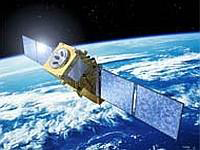US spy satellite’s debris may contain deadly toxic gas
A missile launched from a Navy cruiser soared 130 miles above the Pacific and smashed a dying and potentially deadly U.S. spy satellite Wednesday, the Pentagon said. Two defense officials said it apparently achieved the main aim of destroying an onboard tank of toxic fuel.

Officials had expressed cautious optimism that the missile would hit the satellite, which was the size of a school bus. But they were less certain of hitting the smaller, more worrisome fuel tank, whose contents posed what Bush administration officials deemed a potential health hazard to humans if it landed intact.
In a statement announcing that the attack on the satellite, the Pentagon said, "Confirmation that the fuel tank has been fragmented should be available within 24 hours." It made no mention of early indications, but two defense officials close to the situation said later that it appeared the fuel tank was hit. One said observers saw what appeared to be an explosion, indicating that the tank was hit, the AP reports.
Because the satellite was orbiting at a relatively low altitude at the time it was hit by the missile, debris will begin to re-enter the Earth's atmosphere immediately, the Pentagon statement said.
"Nearly all of the debris will burn up on re-entry within 24-48 hours and the remaining debris should re-enter within 40 days," it said.
In January 2007 China intentionally shot down one of its own aging weather satellites using a modified ballistic missile.
The big question is just how toxic the satellite's fuel might be.
According to the defense department's press release, the fuel tank contains about 1,000 pounds (453 kilograms) of hydrazine, a hazardous chemical related to ammonia.
Hydrazine's effect on people depends on the dose, duration, and manner of exposure, according to a 1997 fact sheet released by the U.S. Agency for Toxic Substances and Disease Registry.
But high doses of the gas can damage skin, burn lung tissue, and affect the nervous system, leading to seizures.
Unless the missile destroys the fuel tank, it is quite likely that the tank and its cargo wouldn't burn up in the atmosphere, defense officials said.
"We had a similar one on [the space shuttle] Columbia that survived reentry" after the shuttle broke apart in February 2003, Marine General James E. Cartwright, vice chair of the Joint Chiefs of Staff, said in a statement.
The tank would probably rupture when it hit the ground, spreading toxic gas over an area Cartwright estimated to be roughly the size of two football fields.
"If you … inhale a lot of it, it could be deadly," Cartwright said.
The equivalent of two football fields is a large impact zone in a big city, The National Geographic reports.
Source: agencies
Subscribe to Pravda.Ru Telegram channel, Facebook, RSS!





